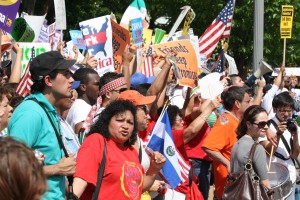According to the Pew Research Center, the percentage of foreign-born population residing in the United States will reach a record of nearly 18% by 2065 if current trends are maintained.
In the 50 years since the 1965 Immigration and Naturalization Act was passed, 59 million immigrants have flooded into the United States.
Immigration since 1965 has swelled the nation’s foreign-born population from 9.6 million then to a record 45 million in 2015.1 (The current immigrant population is lower than the 59 million total who arrived since 1965 because of deaths and departures from the U.S.)2By 2065, the U.S. will have 78 million immigrants, according to the new Pew Research population projections.
The nation’s immigrant population increased sharply from 1970 to 2000, though the rate of growth has slowed since then. Still, the U.S. has—by far—the world’s largest immigrant population, holding about one-in-five of the world’s immigrants (Connor, Cohn and Gonzalez-Barrera, 2013).
The 1965 Act also changed the character of immigrants coming to the United States.
The 1965 Immigration and Nationality Act made significant changes to U.S. immigration policy by sweeping away a long-standing national origins quota system that favored immigrants from Europe and replacing it with one that emphasized family reunification and skilled immigrants. At the time, relatively few anticipated the size or demographic impact of the post-1965 immigration flow (Gjelten, 2015).
After the replacement of the nation’s European-focused origin quota system, greater numbers of immigrants from other parts of the world began to come to the U.S. Among immigrants who have arrived since 1965, half (51%) are from Latin America and one-quarter are from Asia. By comparison, both of the U.S. immigration waves in the mid-19th century and early 20th century consisted almost entirely of European immigrants.
The country’s overall population will feel the impact of these shifts. Non-Hispanic whites are projected to become less than half of the U.S. population by 2055 and 46% by 2065. No racial or ethnic group will constitute a majority of the U.S. population. Meanwhile, Hispanics will see their population share rise to 24% by 2065 from 18% today, while Asians will see their share rise to 14% by 2065 from 6% today.
Public opinion on this massive change has been less enthusiastic then the mainstream media lets on.
For its part, the American public has mixed views on the impact immigrants have had on American society, according to a newly released Pew Research Center public opinion survey. Overall, 45% of Americans say immigrants in the U.S. are making American society better in the long run, while 37% say they are making it worse (16% say immigrants are not having much effect). The same survey finds that half of Americans want to see immigration to the U.S. reduced (49%), and eight-in-ten (82%) say the U.S. immigration system either needs major changes or it needs to be completely rebuilt.
Pew puts the number of illegal aliens in the U.S.
In 2014, 11.3 million unauthorized immigrants lived in the U.S., according to the latest preliminary Pew Research estimate (Passel and Cohn, 2015).Illegal immigration from Mexico has been the main factor in these changes in the U.S. unauthorized immigrant population, though Mexicans remain by far the largest unauthorized immigrant group.




























